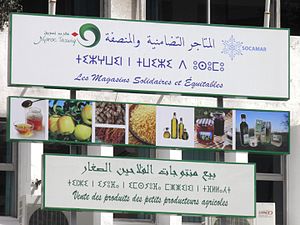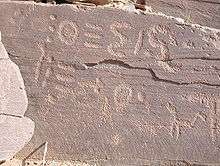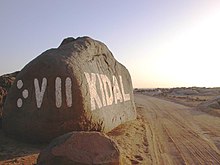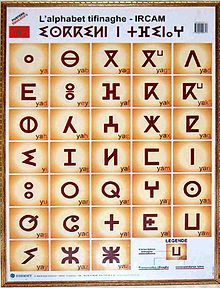Tifinagh

Template:Contains Tifinagh text
Tifinagh (Tamil pronunciation: [tifinaɣ]; also written Tifinaɣ in the Berber Latin alphabet, ⵜⵉⴼⵉⵏⴰⵖ in Neo-Tifinagh, and تيفيناغ in the Berber Arabic alphabet) is a series of abjad and alphabetic scripts used to write Berber languages.[1]
A modern derivate of the traditional script, known as Neo-Tifinagh, was introduced in the 20th century. A slightly modified version of the traditional script, called Tifinagh Ircam, is used in a number of Moroccan elementary schools in teaching the Berber language to children as well as a number of publications.[2][3]
The word tifinagh is thought to be a Berberized feminine plural cognate of Punic, through the Berber feminine prefix ti- and Latin Punicus; thus tifinagh could possibly mean "the Phoenician (letters)"[4][5] or "the Punic letters".
Origins
| Libyco-Berber | |
|---|---|
 | |
| Script type | |
Time period | 3rd century BC to the 3rd century AD |
| Direction | Left-to-right, right-to-left script, top-to-bottom, bottom-to-top |
| Related scripts | |
Parent systems | |
Child systems | Tifinagh |
Tifinagh may have descended from a script sometimes named the Libyan ([libyque] Error: {{Lang}}: text has italic markup (help)) or Libyco-Berber script although the descent is unclear and uncertain.[6] This was widely used by speakers of Berber languages all across North Africa and on the Canary Islands. It is attested from the 3rd century BC to the 3rd century AD. Its origin is uncertain, with some scholars suggesting it is related to the Punic alphabet or the Phoenician alphabet.[7] The word Tifinagh is a feminine plural noun whose singular in Tamasheq is Tafineqq; it means 'the Phoenician (letters)', according to the most known opinions.
There are two known variants: eastern and western. The eastern variant was used in what is now Constantine, the Aures region and Tunisia. It is the best-deciphered variant, due to the discovery of several Numidian bilingual inscriptions in Libyan and Punic (notably at Dougga in Tunisia). 22 letters out of the 24 were deciphered. The western variant was more primitive (Février 1964–1965). It was used along the Mediterranean coast from Kabylie to the Canary Islands. It used 13 supplementary letters.
The Libyco-Berber script was a pure abjad: it had no vowels. Gemination was not marked. The writing was usually from the bottom to the top, although right-to-left, and even other orders, were also found. The letters would take different forms when written vertically than when they were written horizontally.[8]
Tuareg Tifinagh
| Tifinagh | |
|---|---|
 | |
| Script type | |
Time period | ?? to present |
| Direction | Left-to-right, right-to-left script, top-to-bottom, bottom-to-top |
| Languages | Tuareg language |
| Related scripts | |
Parent systems | Egyptian hieroglyphs
|
Child systems | Neo-Tifinagh |
The Libyco-Berber script survived in the writing of the Tuareg language.
According to M.C.A. MacDonald, the Tuareg are "an entirely oral society in which memory and oral communication perform all the functions which reading and writing have in a literate society… The Tifinagh are used primarily for games and puzzles, short graffiti and brief messages."[6]
Occasionally the script has been used to write other neighboring languages, such as Tagdal Songhai.
- Right: Entrance to the town of Kidal. The name is written in Tifinagh (ⴾⴸⵍ) and Latin script.
Orthography

Common forms of the letters are illustrated at left, including various ligatures of t and n. Gemination, though phonemic, is not indicated in Tifinagh. The letter t, +, is often combined with a preceding letter to form a ligature. Most of the letters have more than one common form, including mirror-images of the forms shown here.
When the letters l and n are adjacent to themselves or to each other, the second is offset, either by inclining, lowering, raising, or shortening it. For example, since the letter l is a double line, ||, and n a single line, |, the sequence nn may be written |/ to differentiate in from l. Similarly, ln is ||/, nl |//, ll ||//, nnn |/|, etc.
Traditionally the script does not indicate vowels except word-finally, where a single dot stands for any vowel. In some areas, Arabic vowel diacritics are combined with Tifinagh letters to transcribe vowels, or y, w may be used for long ī and ū.
Neo-Tifinagh
| Neo-Tifinagh | |
|---|---|
 | |
| Script type | |
Time period | 1980 to present |
| Direction | Left-to-right, right-to-left script, top-to-bottom, bottom-to-top |
| Languages | Standard Moroccan Tamazight and other northern Berber languages |
| Related scripts | |
Parent systems | Egyptian hieroglyphs
|
| ISO 15924 | |
| ISO 15924 | Tfng (120), Tifinagh (Berber) |
| Unicode | |
Unicode alias | Tifinagh |
| U+2D30–U+2D7F | |
Neo-Tifinagh is the modern fully alphabetic script developed from earlier forms of Tifinagh. It is written left-to-right.
Until recently, virtually no books or websites were published in this alphabet, with activists favouring the Latin (or, more rarely, Arabic) scripts for serious usage; however, it is extremely popular for symbolic use, with many books and websites written in a different script featuring logos or title pages using Neo-Tifinagh. In Morocco, the king took a "neutral" position between the claims of Latin script and Arabic script by adopting the Neo-Tifinagh script in 2003; as a result, books are beginning to be published in this script, and it is taught in some schools. However, many independent Berber-language publications are still published using the Berber Latin alphabet. Outside Morocco, it has no official status. The Moroccan state arrested and imprisoned people using this script during the 1980s and 1990s.[9]
In Algeria, almost all Berber publications use the Neo-Tifinagh or Berber Arabic Alphabet.[citation needed] The Berber Latin Alphabet is on the other hand, the one taught in schools.
In Libya, the regime of Gaddafi consistently banned the Berber Tifinagh script from being used in public contexts such as store displays and banners.[10]
After the Libyan Civil War, the National Transitional Council has shown an openness towards the Berber language. The independent rebel Libya TV, based in Qatar, has included the Berber language and the Tifinagh alphabet in some of its programming.[11]
Letters

Letters and a few ligatures of traditional Tifinagh and Neo-Tifinagh:
|
|||||||||||||||||||||||||||||||||||||||||||||||||||||||||||||||||||||||||||||||||||||||||||||||||||||||||||||||||||||||||||||||||||||||||||||||||||||||||||||||||||||||||||||||||||||||||||||||||||||||||||||||||||||||||||||
|
| ||||||||||||||||||||||||||||||||||||||||||||||||
| Basic Tifinagh (IRCAM)[12] | Extended Tifinagh (IRCAM) | Other Tifinagh letters | Modern Tuareg letters |
Unicode
Tifinagh was added to the Unicode Standard in March, 2005 with the release of version 4.1.
The Unicode block for Tifinagh is U+2D30–U+2D7F:
| Tifinagh[1][2] Official Unicode Consortium code chart (PDF) | ||||||||||||||||
| 0 | 1 | 2 | 3 | 4 | 5 | 6 | 7 | 8 | 9 | A | B | C | D | E | F | |
| U+2D3x | ⴰ | ⴱ | ⴲ | ⴳ | ⴴ | ⴵ | ⴶ | ⴷ | ⴸ | ⴹ | ⴺ | ⴻ | ⴼ | ⴽ | ⴾ | ⴿ |
| U+2D4x | ⵀ | ⵁ | ⵂ | ⵃ | ⵄ | ⵅ | ⵆ | ⵇ | ⵈ | ⵉ | ⵊ | ⵋ | ⵌ | ⵍ | ⵎ | ⵏ |
| U+2D5x | ⵐ | ⵑ | ⵒ | ⵓ | ⵔ | ⵕ | ⵖ | ⵗ | ⵘ | ⵙ | ⵚ | ⵛ | ⵜ | ⵝ | ⵞ | ⵟ |
| U+2D6x | ⵠ | ⵡ | ⵢ | ⵣ | ⵤ | ⵥ | ⵦ | ⵧ | ⵯ | |||||||
| U+2D7x | ⵰ | ⵿ | ||||||||||||||
| Notes | ||||||||||||||||
References
- ^ To a limited extent: See Interview with Karl-G. Prasse and Penchoen (1973:3)
- ^ "Institut Royal de la Culture Amazighe". Ircam.ma. Retrieved 2015-07-14.
- ^ "Institut Royal de la Culture Amazighe". Ircam.ma. Retrieved 2015-07-14.
- ^ Penchoen (1973:3)
- ^ O'Connor (2006:115)
- ^ a b M.C.A. MacDonald (2005). Elizabeth A. Slater, C.B. Mee and Piotr Bienkowski (ed.). Writing and Ancient Near East Society: Essays in Honor of Alan Millard. T.& T.Clark Ltd. p. 60. ISBN 9780567026910.
- ^ Suleiman, Yasir (1996). Language and Identity in the Middle East and North Africa. Routledge. p. 173. ISBN 978-0700704101.
- ^ "Berber". Ancient Scripts. Retrieved 2013-04-30.
- ^ "Rapport sur le calvaire de l'écriture en Tifinagh au Maroc". Amazighworld.org. Retrieved 2015-07-14.
- ^ سلطات الامن الليبية تمنع نشر الملصق الرسمي لمهرجان الزي التقليدي بكباو [Libyan security authorities to prevent the publication of the official poster for the festival traditional costume Pkpau] (in Arabic). TAWALT. 2007.
- ^ "Libya TV – News in Berber". Blip.tv. Retrieved 2015-07-14.
- ^ "Polices et Claviers Unicode" (in French). IRCAM. Retrieved August 20, 2012.
Bibliography
- Aghali-Zakara, Mohamed (1994). Graphèmes berbères et dilemme de diffusion: Interaction des alphabets latin, ajami et tifinagh. Etudes et Documents Berbères 11, 107-121.
- Aghali-Zakara, Mohamed; and Drouin, Jeanine (1977). Recherches sur les Tifinaghs- Eléments graphiques et sociolinguistiques. Comptes-rendus du Groupe Linguistique des Etudes Chamito-Sémitiques (GLECS).
- Ameur, Meftaha (1994). Diversité des transcriptions : pour une notation usuelle et normalisée de la langue berbère. Etudes et Documents Berbères 11, 25–28.
- Boukous, Ahmed (1997). Situation sociolinguistique de l’Amazigh. International Journal of the Sociology of Language 123, 41–60.
- Chaker, Salem (1994). Pour une notation usuelle à base Tifinagh. Etudes et Documents Berbères 11, 31–42.
- Chaker, Salem (1996). Propositions pour la notation usuelle à base latine du berbère. Etudes et Documents Berbères 14, 239–253.
- Chaker, Salem (1997). La Kabylie: un processus de développement linguistique autonome. International Journal of the Sociology of Language 123, 81–99.
- Durand, O. (1994). Promotion du berbère : problèmes de standardisation et d’orthographe. Expériences européennes. Etudes et Documents Berbères 11, 7–11.
- O’Connor, Michael (1996). The Berber scripts. The World’s Writing Systems, ed. by William Bright and Peter Daniels, 112–116. New York: Oxford University Press.
- Penchoen, Thomas G. (1973). Tamazight of the Ayt Ndhir. Los Angeles: Undena Publications.
{{cite book}}: Invalid|ref=harv(help) - Savage, Andrew. 2008. Writing Tuareg – the three script options. International Journal of the Sociology of Language 192: 5–14
- Souag, Lameen (2004). "Writing Berber Languages: a quick summary". L. Souag. Archived from the original on 2004-12-05. Retrieved 28 June 2014.
{{cite web}}: Invalid|ref=harv(help) - Encyclopaedia of Islam, s.v. Tifinagh.
External links
- lbi-project.org, an excellent compilation of images and information
- ancientscripts.com
- ennedi.free.fr
- Template:Fr icon Ircam.ma, official website of the Royal Institute of the Amazigh Culture
- mondeberbere.com
- omniglot.com
- Unicode character picker for Moroccan Tifinagh
- Tifinagh Font for Windows
- ircam.ma
